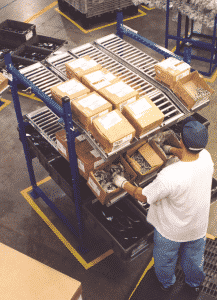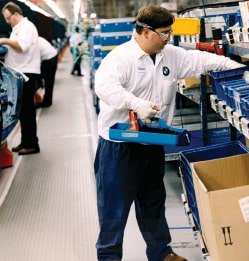Four Reasons to Fall for Flow Cell
As the newest member of the Unex Manufacturing family, I have by far the least amount of experience working with Flow Cell units. So when it came time to begin taking new photographs of an array of differently arranged Flow Cell structures, I was understandably nervous about being in charge of assembling said structures. I was left in an empty room with several pallets of tracks and Flow Cell parts, some drawings of the desired arrangements, and a socket wrench. I wiped the sweat from my brow, took a deep breath, and dove in.
When I was done, I stood proudly before them and admired my work. After building four different Flow Cell structures, I left that room a changed man- my rite of passage at Unex Manufacturing was complete, so to speak. I had built something large and tangible- and it didn't even fall apart when I leaned against it! Most importantly, I had learned so much more about our product than I could just by doing my homework. My experiences with Flow Cell highlighted four advantages in particular.
1. Intuitive
If you're anything like me, you're not much of a fan of reading directions. I appreciate a product that you can look at and almost instantaneously understand how it should be put together. If it involves measuring and cutting, forget about it. I have to solder that together? No thanks. More complex assembly requires more time and personnel, and may require skilled workers to assemble (No one is going to let me get near a soldering gun). The Flow Cell structures are so intuitive that it's nearly impossible to assemble them incorrectly (That's not a challenge, by the way). I was able to reference the included CAD drawing to see exactly where the posts and beams needed to be located, and the clearly labelled hardware kits make assembling the parts a cinch. Not once did I need to read the directions, even for my first structure. The Flow Cell units are designed to make assembly incredibly simple. Even for me.
2. Easy
I said "Even for me" above for a very specific reason- I am absolutely not a mechanically inclined individual. The other week, my fan started making a clicking noise. I broke it even further just by trying to open the casing. My father taught me many things, but being good with a tool is not one of those things. I say this so you can understand how excited I was to discover I only needed one tool to assemble the Flow Cell- a socket wrench. Portions of the Flow Cell don't even need a socket wrench. The steel pick shelves drop right onto the beams. Since I was using low profile track, all I had to do to complete the structures was drop the track onto the beams. The Flow Cells are not only easy to understand- they're easy to build too.
3. Fast
I must start by saying that we recommend putting a Flow Cell together with two people. Holding a beam in the air while you bolt one end of it into a post can get quite annoying, and it will take you a bit longer to tighten up all the bolts and finish up. Having said that, I was able to put together the first structure by myself in just about an hour, and lowered that time significantly with the next structure. Luckily, I wasn't alone the whole time, and with another person in the mix we built the remaining structures in about a half an hour each. When I had to rearrange the levels on one of the Flow Cells, I was able to do so in about fifteen minutes. The quick assembly time of the Flow Cell, as well as the speed with which it can be modified to fit one's needs, are huge assets to an operation that's accustomed to rapid change.
4. Light
Once all the structures were built, I realized I was now tasked with the Herculean feat of moving them across the room. The fact that casters can be added to a Flow Cell of course resolves this issue for everyone except me. Unfortunately, we were shooting on a pure white floor, so rolling casters all over it wasn't an option. The Flow Cell units are so light without the tracks loaded in that I was able to push them around the room without casters by myself. When it came time to shoot on the white floors, it only took two people to lift the structure and drop it in place. Even without casters, the Flow Cell units are extremely light and can be easily moved as needed. Despite their lightweight construction, these Flow Cells aren't weak- each level is rated to hold up to 1,000 pounds.
I can now safely say that I absolutely recommend using Flow Cell structures in your operation. Their assembly is extremely easy to understand and even easier to execute. The time and manpower required to assemble Flow Cells are minimal, and they are light and durable enough to be moved and rearranged to meet your changing needs. If you're anything like me, these four features make Flow Cells a must-have for your operation.
